SAMSUNG UE32H6400, UE40H6400, UE48H6400, UE50H6400, UE55H6400 User Manual
...
E-MANUAL
Thank you for purchasing this Samsung product.
To receive more complete service, please register your product at
www.samsung.com/register
Model______________ Serial No.______________
Contents
Quick Guide
Using the Smart TV
Using Voice Control
Using Motion Control
Using the Samsung Smart Control
Using the Football Mode
Using the Multi-Link Screen
Editing channels
Connecting Antenna and External devices
Aerial Connection
Video Device Connection
13HDMI Connection
14Component Connection
15External Input Connection
16SCART Connection
TV Audio through the External Speakers
17HDMI (ARC) Connection
18Digital Audio (Optical) Connection
19Headphone Connection
20Audio Output Connection
Connecting to a Computer
22Connecting via HDMI Port
23Connecting with the HDMI (DVI) Port
24Connecting via Samsung Link
24 Connecting via Home Network (DLNA)
Connecting with a Mobile Device
26 Mobile Device Screen on TV (Screen Mirroring)
26Connecting Mobile Devices without a Wireless Router (Wi-Fi Direct)
27 Connecting via Samsung Link
27 Connecting via Home Network (DLNA)
27Connecting via Smart View
28Name of TV on Network
Input Signal Selection
Using Remote and Peripheral
Devices
Inserting Batteries into Samsung Smart Control
29 When you see this alarm icon on the screen...
Pairing Samsung Smart Control
30 Reconnecting Samsung Smart Control
Using Samsung Smart Control
31 Button Functions
34Using the TV by Moving the Samsung Smart Control
35Using the TV with the Touchpad
37Displaying the Remote Control on the Screen (virtual remote control)
Controlling External Devices with the TV Remote
(Universal Remote Setup)
39Setting Up the Universal Remote Control
40Controlling External Devices with the TV Remote
Controlling the TV with a Keyboard
42Connecting a Keyboard
43Using the Keyboard
Controlling the TV with a Mouse
44Connecting a Mouse
45Using the Mouse
Internet Connection
Establishing a Wired Internet Connection
46Connecting a LAN Cable
47Connecting to a Wired Internet Network Automatically
47 Connecting to a Wired Internet Network Manually
Establishing a Wireless Internet Connection
49Connecting to a Wireless Internet Network Automatically
50Connecting to a Wireless Internet Network Manually
51Connecting to a Wireless Internet Network with WPS
Troubleshooting Internet Connectivity Issues
52Troubleshooting Wired Internet Connectivity Issues
53Troubleshooting Wireless Internet Connectivity Issues
Checking the Internet Connection Status
Smart Features
Multiple Functions on a Single Screen
55Launching Multi-Link Screen
55Using Multi-Link Screen
55Selecting a Feature
55Changing the Channel/Volume
56Pairing Bluetooth Headphones
56 Selecting the Audio-Source Screen
Smart Hub
58 Using the Smart Hub Tutorial
58 Resetting Smart Hub
Using Smart Hub with Samsung Account
69Installing an App
70Default Apps
70Rearranging Apps on the SAMSUNG APPS Screen
71Removing an App from the TV
71Rating/Reviewing an App
72Updating an App
72 SAMSUNG APPS Features
Using On TV Panel
76 Using Pop-Up Menu Functions
76Viewing Detailed Programme Information
77Configuring On TV Settings
Using FILMS AND TV SHOWS Panel
79Using Pop-Up Menu Functions
80Watching a Movie/TV Programme
80 Restricting Purchased Content Viewing
80Registering Content to Favourites
81Rating and Sharing a Purchased Content
Playing Photos, Videos, and Music (MULTIMEDIA)
83Playing Media Content from a USB Device
84Playing Multimedia Content Saved in a Computer/Mobile Device
86Playing Media Content from a Storage Service
87Buttons and Functions Available while Viewing Photos
88Buttons and Functions Available while Watching Video
90Buttons and Functions Available while Playing Music
91Functions on the Media Content List Screen
TV Control using your Voice
59 |
Creating a Samsung Account |
92 |
Enabling Voice Control |
|
|
||
61 |
Signing into Samsung Account |
94 |
Using the Voice Interaction function Interactively |
|
|
||
62 |
Linking My Samsung and App Accounts |
TV Control using Motions |
|
63 |
Changing and Adding Information to Samsung Account |
95 |
Testing Ambient Illumination Using the TV Camera |
63 |
Deleting All Samsung Accounts from the TV |
96 |
Activating Motion Control |
Using the Games Panel |
99 |
Motion Control Screen Layout |
|
|
|
||
64 |
Using Pop-Up Menu Functions |
Signing in with Face Recognition |
|
64 |
Installing and Running a Game |
103 |
Registering Your Face to Your Samsung Account |
66 |
Managing Downloaded or Purchased Games |
104 |
Changing Login Method to Face Recognition |
Using SAMSUNG APPS Panel |
104 |
Singing into Samsung Account with Your Face |
|
|
|
||
68 Using Pop-Up Menu Functions
TV Viewing and Recording Features
Digital Broadcast Information at a Glance
105Using the Guide
106Checking the Current Programme Info
106 Change the Broadcast Signal
106 Digital Signal Info and Strength
Recording Programmes
107 Creating a USB Recording Device
109Recording Programmes
110Buttons and Functions Available While Recording a Programme
111Managing the Schedule Recording List
112Viewing Recorded Programmes
115 Managing Recorded Files
Setting Up a Schedule Viewing
116Setting Up Schedule Viewing
117Managing the Schedule Viewing List
Using Timeshift
Using the Channel List
Registering, Removing, and Editing Channels
120Registering and Removing Channels
121Editing Registered Channels
121 Enabling/Disabling Password Protection on Channels
121 Locking/ Unlocking Channels
Creating a Personal Favourites List
122Registering a Channel as Favourites
123Viewing Favourites List Channels Only
123Editing a Favourites List
Adding Realism to Sports
126 Enabling Football Mode
126Extracting Highlights Automatically
127Functions Available in Football Mode
128Viewing a Sports Event Recorded in Football Mode
TV-Viewing Support Features
129 Showing Subtitles
129 Subtitle Options
130 Changing Teletext Language
130PIP Broadcast Viewing
131Scanning for Available Channels
132Selecting the Broadcast Audio Options
132 Audio Description
132 Genre Selection
132 Adult genre enabling
Using the Channel Settings
133 Country (Area)
133Manual Tuning
134Fine-Tuning the Screen
135Transfer Channel List
135 Delete CAM Operator Profile
135 Satellite System
137 Common Interface
Picture and Sound Settings
Changing the Picture Mode and Adjusting the Picture
Quality
138Choosing the Right Picture Mode for the Viewing Environment
139Adjusting the Picture Quality for Each Picture Mode
140Fine-Tuning Each Picture Mode (Advanced Settings)
142 Adjusting the Picture for Easier Viewing (Picture Options)
Viewing in 3D
144Starting 3D
145Changing the 3D Mode
146Adjusting the 3D Effect
Picture Support Functions
147PIP Broadcast Viewing
148Changing the Picture Size and Position
149Listening to Audio Only with the Screen Turned Off (Picture Off)
149 Resetting the Picture Mode Settings
Changing the Sound Mode and Using Sound Effects
150Choosing the Right Sound Mode for the Environment
151Using Sound Effects
Sound Support Functions
152 Selecting Speakers
152 Designating the TV's Installation Type
152Listening to TV Sound through Samsung Bluetooth Audio
153Enabling the Sound (Additional Settings)
154Listening to 3D Audio in 3D Mode
154 Resetting All Sound Settings
General
Setting the Time and Using the Timer
155Setting the Current Time
156Using the Timers
Using the Screen Burn Protection and Energy Saving
Features
158 Preventing Screen Burn
158 Using Energy Saving Features
Using Anynet+ (HDMI-CEC)
159Setting Up Anynet+ (HDMI-CEC)
160Using Anynet+ (HDMI-CEC)
Using the e-Manual
161 Launching the e-Manual
161Additional e-Manual Features
162Updating the e-Manual to the Latest Version
Updating the Software
163 Updating Software over the Internet
163Updating Software using a USB connection
164Enabling Automatic Software Updates
164 Software update via satellite channel
Protecting the TV from Hacking and malicious code
164Checking the TV and Connected Storage Media
165Automatically Scanning when the TV is Powered On
165 Automatically Adding malicious code to the Blocked List
Using Other Functions
166Enabling Voice Guide for the Visually Impaired
167Enabling the High Contrast
167Adjusting the Menu Transparency
168Expanding the Smart Hub's Focus Area
168Changing the Menu Language
168 Checking Notifications
168Setting Up a Password
169Programme Rating Lock
169Enabling Game Mode
169Enjoying Rich Colours and Superior Picture Quality (BD Wise)
170Enabling/Disabling Sound Feedback
170 Locking/Unlocking the Panel Keys
170Showing/Hiding the Samsung Logo while Booting
171Registering the TV as a DivX-Certified Device (Watching Paid DivX Movies)
172Restoring the TV to the Factory Settings
172 Turning the TV into a Display Model (for retail stores)
Data Service
173 Auto Run Data Service
173 Using Data Service
HbbTV
Connecting to a TV Viewing Card slot
175To connect the CI CARD, follow these steps:
176To connect the CI CARD Adapter, follow these steps:
Teletext Feature
Troubleshooting
Getting Support
180 Support through Remote Management
182 Finding the Information You Need for Service
There is a problem with the screen
182 Testing the Picture
I can't hear the sound clearly
185 Testing the Sound
I can't see 3D images clearly.
186 Testing 3D Picture Quality
There is a problem with the broadcast.
The computer won't connect.
I can't connect to the Internet.
Data Service
The Schedule Recording/Timeshift function isn't working.
Anynet+ (HDMI-CEC) isn't working.
I am having trouble launching/using apps.
My file won't play.
I want to reset the TV.
Other Issues
Notes and Precautions
Before Using the Recording and Timeshift Functions
194Before Using the Recording and Schedule Recording Functions
195Before the Using Timeshift Function
S-Recommendation Disclaimer
196 S Recommendation with Voice Interaction
196 S Recommendation
Before Using 3D Viewing Mode
197 3D Precautions
200 Supported Resolutions for each 3D Mode
Read Before Using Voice, Motion, or Face Recognition
202 Precautions for Voice, Motion and Face Recognition
204Requirements for Using Voice, Motion, or Face Recognition
Read Before Using SAMSUNG APPS
WebBrowser Restrictions
Photo, Video, and Music File Limitations
209Storage Device File Transfers
210Supported External Subtitles
210Supported Internal Subtitles
211Supported Image Formats and Resolutions
211Supported Music Formats and Codecs
212Supported Video Codecs
Restrictions
214 Restrictions to PIP (Picture-in-Picture)
Read After Installing the TV
215 Picture Sizes and Input Signals
215Installing an Anti-Theft Kensington Lock
216Read Before Setting Up a Wireless Internet Connection
Computer Connection Precautions
217 IBM
217MAC
218VESA DMT
219LED 4500 series
219IBM
219MAC
219 VESA DMT
Licence
Glossary
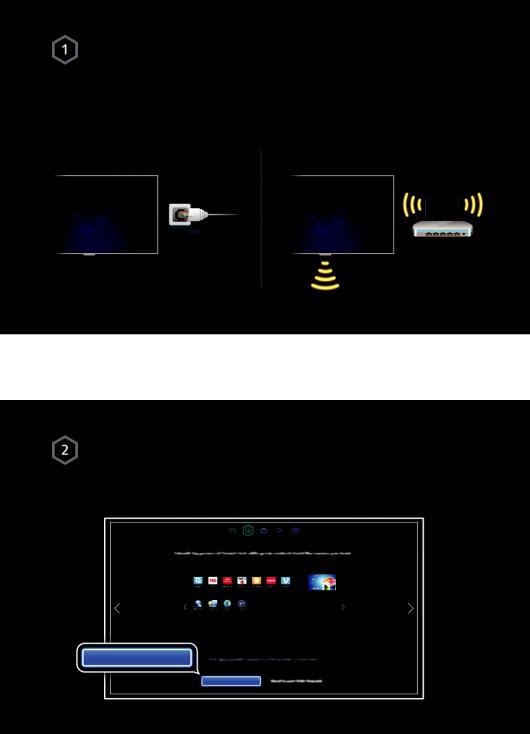
Using the Smart TV
"Availability depends on the specific model and area.
Connecting the TV to the internet
1.Connect the TV to the internet via wired or wireless connection.
2.Set up Network Settings via Network > Network Settings.
Setting up Smart Hub
The first time you start Smart Hub, you need to set it up. Follow the directions on the screen.
Set Up Smart Hub
Set Up Smart Hub
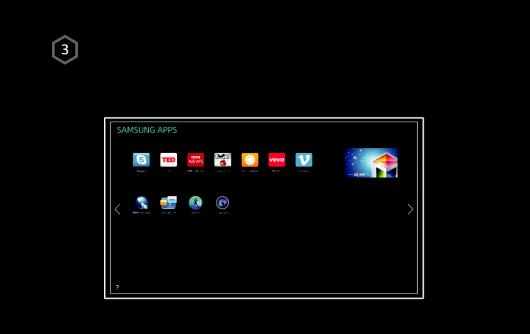
Using Smart Hub
Go to Smart Hub > Apps and download applications from Samsung Smart TV.
"For more information, refer to "Smart Hub?".
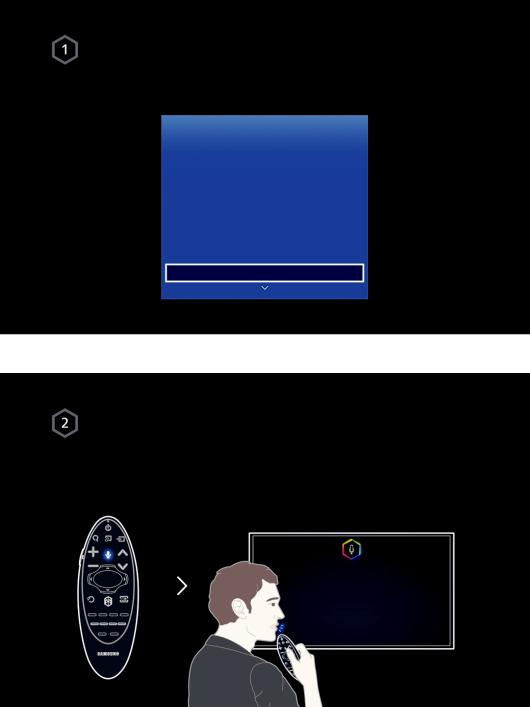
Using Voice Control
"Availability depends on the specific model and area.
Setting up Voice Control
Set up the desired value via System > Voice Control.
System
Accessibility
Setup
Football Mode
Menu Language |
English |
Smart Control Settings
Universal Remote Setup
Voice Control
Using Voice Control
Press the VOICE button on the Samsung Smart Control, and then say the desired commands.
"For more information, refer to "TV Control using your Voice".
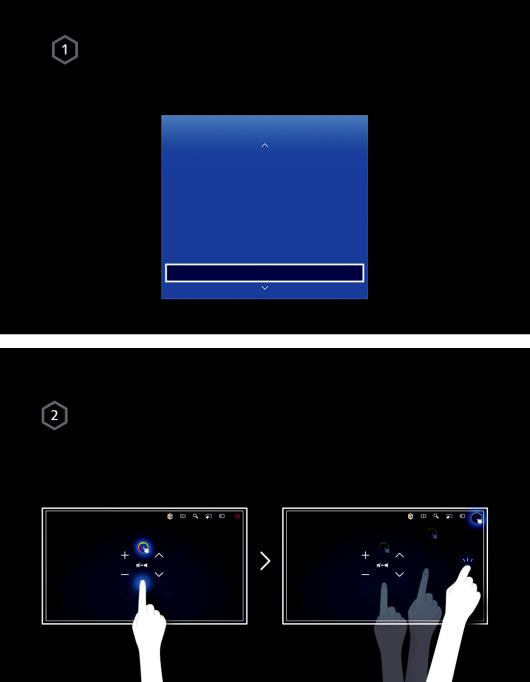
Using Motion Control
"Availability depends on the specific model and area.
Setting up Motion Control
Enter required values via System > Motion Control.
System
Setup |
|
Football Mode |
|
Menu Language |
English |
Smart Control Settings |
|
Universal Remote Setup |
|
Voice Control |
|
Motion Control |
On |
Using Motion Control
1.Raise a hand with stretching an index finger, until an arrow cursor appears on the screen.
2.Move the hand to move the pointer on the screen, and then gesture like clicking a mouse to click a button.
"A TV camera (sold separately) needs to be connected in order to use Motion Control.
"For more information, refer to "TV Control using Motions".
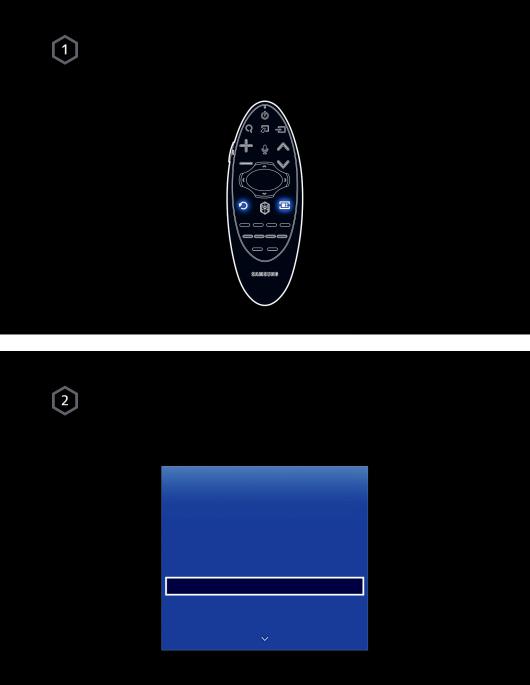
Using the Samsung Smart Control
"Availability depends on the specific model and area.
Connecting the TV
Press RETURN button and GUIDE button simultaneously for 3 seconds.
Setting the Samsung Smart Control
Set the Smart Control Settings via System > Smart Control Settings.
System
Accessibility
Setup
Football Mode
Menu Language |
English |
Smart Control Settings
Universal Remote Setup
Voice Control
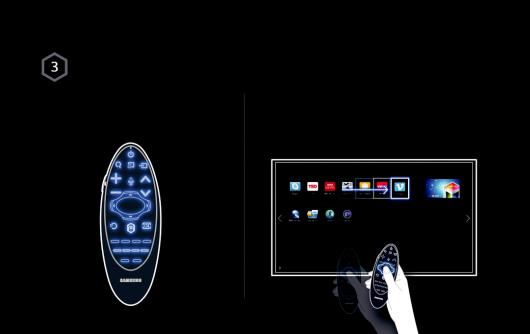
Using the Samsung Smart Control
Use the buttons to perform actions. |
Move the Samsung Smart Control while |
|
touching the touchpad to move the focus. |
"For more information, refer to "Using Samsung Smart Control".

Using the Football Mode
"Availability depends on the specific model and area.
Activating Football Mode
To record the sports game, connect the USB device to the TV and go to System > Football Mode. Set Football Mode to On.
System
Accessibility
Setup
Football Mode
Menu Language |
English |
Smart Control Settings
Universal Remote Setup
Voice Control
Using Football Mode
Press enter while watching a sports game and then press the desired button on the screen. Record, use social media, zoom, and save and view highlights.
"For more information, refer to "Adding Realism to Sports".
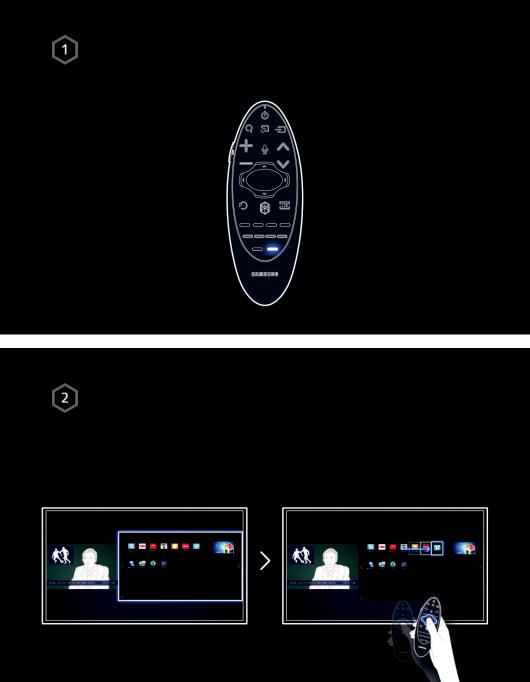
Using the Multi-Link Screen
"Availability depends on the specific model and area.
Running Multi-Link Screen
Press the M.SCREEN button.
Using the Multi-Link Screen
Search the internet or use apps while watching TV.
"For more information, refer to "Multiple Functions on a Single Screen".
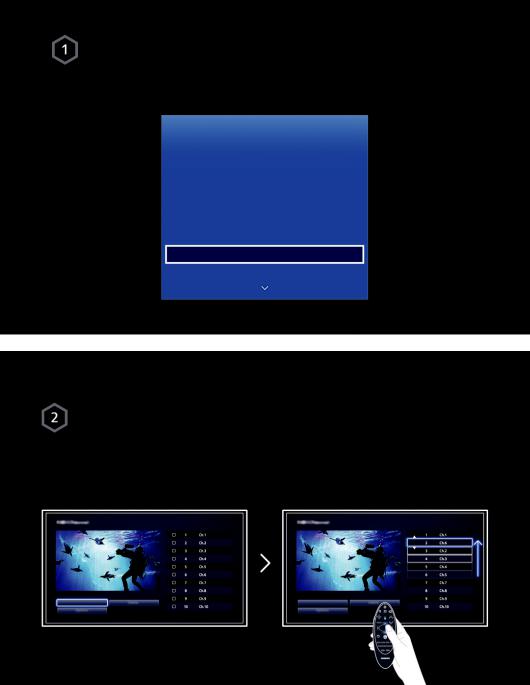
Editing channels
"Availability depends on the specific model and area.
Running Editing Channel
Run Edit Channel and go to Broadcasting > Edit Channel.
Broadcasting
Auto Tuning
Aerial |
Cable |
Channel List
Guide
Schedule Manager
Edit Channel
Edit Favourites
Change the channel number or name
Select Change Number, and then change the channel's order in the list.
Change Number |
Change Number |
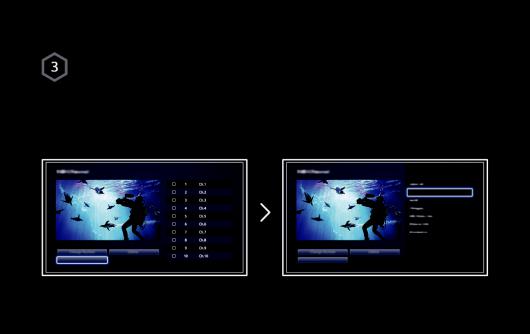
Sorting the channel list
1.Select a digital channel in the list and then select Options > Sorting.
2.Select a desired method for sorting the list.
Sorting
Options |
Options |
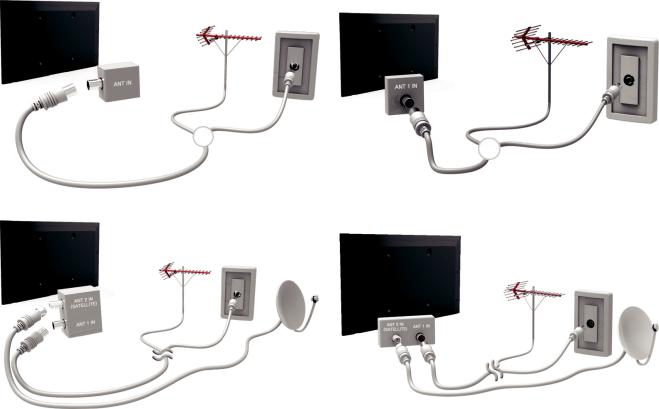
Aerial Connection
"Availability depends on the specific model and area.
Before connecting any external devices and cables to the TV, first verify the model number. A sticker containing the model number is attached to the back of the TV. The connection method varies depending on the model.
An aerial must be connected to the TV in order to receive broadcast signals.
"An aerial connection is not necessary when a cable box or satellite receiver is used.
Connect the correct aerial cable according to your viewing environment to the TV's aerial connector, as shown in the diagram.
Video Device Connection
"" Availability depends on the specific model and area.
Your TV has a variety of connectors for video input from external devices such as cable boxes, satellite receivers, Blu-ray players, DVD players, camcorders, and gaming consoles. Below is a list of featured connectors shown in descending order of picture quality.
●● HDMI
●● Component
●● External Input
Connect a video device to the TV via an HDMI connector for the best picture quality. If the device does not have an HDMI connector, try a component connector to get the next best picture quality.
"" The number of connectors and their names and locations may vary depending on the model.
"" Refer to the external device's operating manual when connecting it to the TV. The number of external device connectors and their names and locations may vary depending on the manufacturer.
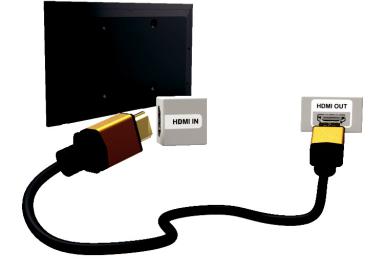
HDMI Connection
Before connecting any external device or cable to the TV, first verify the TV's model number. A sticker containing the model number is attached to the back of the TV. The connection method varies depending on the model.
The following types of HDMI cables are recommended:
●High-Speed HDMI Cable
●High-Speed HDMI Cable with Ethernet HDMI cables have certain requirements:
"Use an HDMI cable with a thickness of 14 mm or less.
"Using a non-certified HDMI cable may result in a blank screen or a connection error.
"Some HDMI cables and devices may not be compatible with the TV due to different HDMI specifications.
"This TV does not support HDMI Ethernet Channel. Ethernet is a LAN (Local Area Network) built with coaxial cables standardised by the IEEE.
Refer to the diagram and connect the HDMI cable to the video device's HDMI output connector and the TV's HDMI input connector.
"The number of connectors and their names and locations may vary depending on the model.
Once the connection has been made, you will be able to select the connected external device using the SOURCE button.

Component Connection
Before connecting any external devices and cables to the TV, first verify the model number of the TV you purchased. A sticker containing the model number is attached to the back of the TV. The connection method varies depending on the model.
Refer to the diagram and connect the Component cable to the TV's component input connectors and the device's component output connectors.
Make sure the cable colours match the connector colours.
Once the connection has been made, you will be able to select the connected external device using the SOURCE button.

External Input Connection
Before connecting any external device or cable to the TV, first verify the TV's model number. A sticker containing the model number is attached to the back of the TV. The connection method varies depending on the model.
Refer to the diagram and connect the AV cable to the TV's AV input connectors and the device's AV output connectors.
If you are using the TV's AV input connectors, connect the video cable to the Y connector. Some models feature a video connector as well. In this case, connect the cable to the video connector.
Once the connection has been made, you will be able to select the connected external device using the SOURCE button.
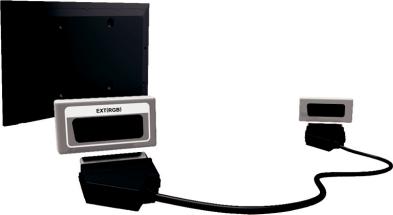
SCART Connection
"Availability depends on the specific model and area.
Before connecting any external devices and cables to the TV, first verify the model number of the TV you purchased. A sticker containing the model number is attached to the back of the TV. The connection method varies depending on the model.
Connect the TV’s SCART input connector to the device’s SCART output connector using a SCART cable. An extra audio connection is not needed because SCART also carries audio.
"SCART can only carry standard-definition video.

TV Audio through the External Speakers
Your TV has a variety of connectors for audio input from devices such as Blu-ray players and DVD players and for audio output to such devices as amplifiers. The connectors are listed below.
●ARC (Audio Return Channel)
●Digital Audio (Optical)
There are several issues to bear in mind when using audio input:
●For better audio quality, it is a good idea to use an AV receiver.
●The number of connectors and their names and locations may vary depending on the model.
●Refer to the external device's operating manual when connecting it to the TV. The number of external device connectors and their names and locations may vary depending on the manufacturer.
HDMI (ARC) Connection
"Some models may not support ARC.
Before connecting any external devices and cables to the TV, first verify the model number of the TV you purchased. A sticker showing the model number is attached to the back of the TV. The connection method varies depending on the model.
ARC (Audio Return Channel) enables digital sound output using just an HDMI cable. However, ARC is only available through the HDMI (ARC) port and only when the TV is connected to an ARC-enabled AV receiver.
"The number of connectors and their names and locations may vary depending on the model.
Connect an HDMI cable to the TV's HDMI (ARC) connector and the device's HDMI output connector.
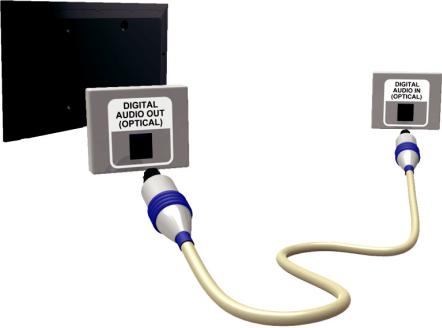
Digital Audio (Optical) Connection
"Availability depends on the specific model and area.
Before connecting any external device or cable to the TV, first verify the TV's model number. A sticker showing the model number is attached to the back of the TV. The connection method varies depending on the model.
Connecting an AV receiver to the TV via a digital audio (optical) connector lets you listen to digital audio.
Connecting a device using an optical cable does not automatically turn off the TV speakers. To turn off the TV's speakers, set TV Sound Output (Sound > Speaker Settings > TV Sound Output) to something other than TV Speaker.
Adjust the audio device's volume using its remote control.
"An unusual noise coming from the audio device while you are using it may indicate a problem with the audio device itself. If this occurs, ask for assistance from the audio device manufacturer.
"Digital audio is only available with 5.1-channel broadcasts.
Refer to the diagram and connect the optical cable to the TV's digital audio output connector and the device's digital audio input connector.
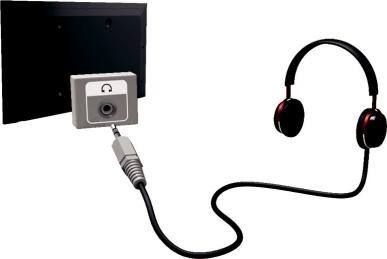
Headphone Connection
"Availability depends on the specific model and area.
Before connecting any external device or cable to the TV, first verify the TV's model number. A sticker containing the model number is attached to the back of the TV. The connection method varies depending on the model.
Refer to the diagram and connect the headphones to the headphone output connector. Only use headphones with a 3-conductor TRS type jack. The headphone volume and the TV volume are adjusted independently of each other. While the headphone is connected, the TV speakers are muted and certain Sound options are deactivated.
"The connectors may not be supported depending on the model.
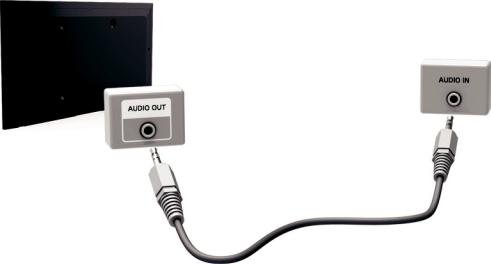
Audio Output Connection
"Availability depends on the specific model and area.
Before connecting any external device or cable to the TV, first verify the TV's model number. A sticker containing the model number is attached to the back of the TV. The connection method varies depending on the model.
"The connectors names and locations may vary depending on the model.
Refer to the diagram and connect the audio cable to the TV's audio output connector and the device's audio input connector.
Connecting to a Computer
You can directly connect a computer to the TV or to the network to view the computer screen or content on the TV. Connect the computer to the TV as follows.
●● Connecting via HDMI Port
You can connect the computer to the TV using the HDMI cable to display the computer screen on the TV.
●● Connecting with the HDMI (DVI) Port
You can connect a computer to the TV by connecting the computer's DVI port to the TV's HDMI port with the DVI to HDMI cable to display the computer screen on the TV.
●● Connecting via Samsung Link
Quickly access the photo, video and music files saved on a computer on which Samsung Link software is installed, even if you do not connect the TV directly to the computer.
●● Connecting via Home Network (DLNA)
Quickly access the photo, video and music files saved on a computer by connecting the TV and the computer to the same router or AP.
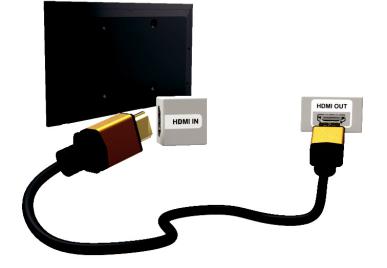
Connecting via HDMI Port
Before connecting any external device or cable to the TV, first verify the TV's model number. A sticker showing the model number is attached to the back of the TV. The connection method varies depending on the model.
For HDMI connection, one of the following HDMI cable types is recommended:
●High-Speed HDMI Cable
●High-Speed HDMI Cable with Ethernet
"Use an HDMI cable with a thickness of 14 mm or less. Using a non-certified HDMI cable may result in a blank screen or a connection error.
"Some HDMI cables and devices may not be compatible with the TV due to different HDMI specifications.
"This TV does not support HDMI Ethernet Channel. Ethernet is a LAN (Local Area Network) built on coaxial cables standardised by the IEEE.
"Some computers do not support HDMI interface, depending on its graphics adapter specifications. In this case, use a DVI-to-HDMI cable to connect the computer to the TV.
Refer to the diagram and connect the HDMI cable to the external video device's HDMI output connector and the TV's HDMI input connector.
Once the connection has been made, you will be able to select the connected external device using the SOURCE button.
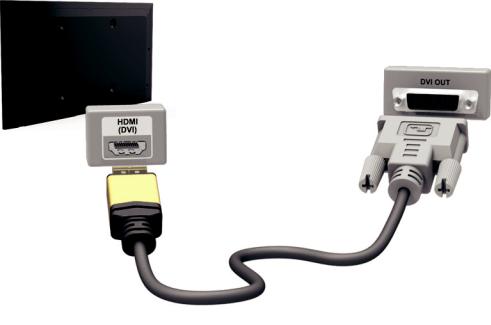
Connecting with the HDMI (DVI) Port
If the graphics adapter of your computer does not support HDMI interface, connect the computer to the TV with the DVI (Digital Visual Interactive) to HDMI cable. However, DVI-to-HDMI connection is supported by the HDMI port for DVI only and does not support audio signal transmission. To listen to the computer sound, connect the external speaker to the computer's audio output connector.
"For information on resolutions supported by the TV, refer to "Computer Connection Precautions".
Refer to the diagram and connect the DVI-to-HDMI cable to the TV's HDMI (DVI) port and the computer's DVI output port.
Once the connection has been made, you will be able to select the connected external device using the SOURCE button.
Connecting via Samsung Link
Quickly access photo, video and music files saved on a computer with Samsung Link software installed. Also, use Samsung Link to play and view the content of a computer that has been registered to Samsung Link under your Samsung account, even if the computer and the TV are not connected to the same router or AP.
111Visit the Samsung content and service portal (http://link.samsung.com) on a computer and sign into your Samsung account.
"" To install Samsung Link desktop software, you will need to first sign into your Samsung account. If you don't have a Samsung account, create one first.
222Install Samsung Link desktop software. When the installation is complete, the computer will be registered to Samsung Link.
333Specify the folder you wish to link to the TV. You can view and play photo, video and music files contained in the specified folder on the TV screen.
"" For more information on using Samsung Link desktop software, refer to the software's Help section.
Connecting via Home Network (DLNA)
Quickly access and view/play photo, video and music files from a computer on the TV screen.
111Connect the TV and the computer to the same router or AP. A home network will be configured once the two connections are established.
"" Home Network (DLNA) enables content-sharing between the TV, computers and mobile devices connected to the same wired or wireless router.
222From the computer, select [Control Panel] > [Network and Internet] > [Network and Sharing Centre] > [Change advanced sharing settings] and select [Choose media streaming options...] to activate media streaming.
333 From the list, set TV to [Allowed].
444Launch Windows Media Player from the computer, select [Settings] > [Library Management] and then add the location where the photo, video and music files are saved to view/play the files on the TV screen.
"" It will be possible to view/play on the screen files moved to Windows Media Player's default folder.
"" As long as File Sharing is activated, unauthorised access may be allowed. Disable File Sharing if data access is not required.
